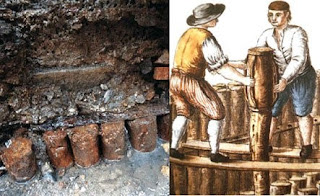“General Grant seriously remarked to a particularly bright young woman that Venice would be a fine city if it were drained.” – Henry Adams, The Education of Henry Adams
Venice is a water-focused city. Built on islands, the canals serve the same purpose as streets do in other locales. Global warming is pushing sea levels to rise and water, instead of enhancing the Venetian experience, is threatening its very existence.
Venice, a World Heritage site, has always struggled with water, trying to stay one step ahead of the rising tides. Scientists project the city could be underwater in less than a century. Venice is also experiencing shift plate tectonics; the ground underneath the city is sinking and settles at a rate of approximately 4 inches per century.
In the Beginning. Emerging from the Mud
In the 5th century, the first Venetians were running from German and Hun invaders and picked this mosquito marsh in the northern Adriatic Sea because if offered protection – it is one of a dozen islands in the middle of a 200-squre mile shallow lagoon. The settlers hammered giant wood pilings 10-15 feet into the ground, placed planks on top of the pillars and marble foundations on the planks. They redirected the rivers, aiming them at the sea instead of the lagoon.
The Hazard
The major threat to Venice is extreme high tides “acqua alta.” Officially the situation occurs when the water level of high tide is rises 3.54 inches above normal. This happens most frequently around the Piazza San Marco; however, even at normal high tides the Basilica San Marco area can be flooded. When the acqua alta occurs, most of the city can be impacted and people have to be evacuated. The acqua alta has increased in frequency and can occur 60+ days a year.
Increasing the hazards are rising sea levels. Many ground floors of palazzi, boat houses and homes are being abandoned throughout Venice as they are flooded (or half-flooded) with seawater from the rising sea levels.
To add to the Venice water challenge, deep canals were dredged in the lagoon to allow large ships to reach the newly developed part and industrial petrochemical complex at Marghera. Additional dredging was allowed to facilitate mega-cruise ships direct access to the mainland of Venice.
MOSE to the Rescue (Perhaps)
Started in 2003, Project MOSE (Modulo Sperimental Elettromeccanico) is the acronym for the experimental model for a series of 79 hollow steel gates that will be raised to hold back the sea in time of acqua alta. It is also named for the biblical leader who parted the Red Sea.
When tides are low and weather calm, the gates are filled with water and rest on the bottom of three channels (north and south ends of the Lido and fishing village of Chioggia on lagoon’s southern end). When required, engineers activate the system that pumps compressed air into the gates forcing out the water; the gates rotate into position under their own buoyancy, forming a barrier against the surging seas.
The concept for MOSE started in the 1970s and in December 2001 the government finally approved plans to build the gates (projected costs of $ 2billion – $3 billion). Not everyone approved the project. Italian and international environmentalists and scientists disapproved the project believing that it would be obsolete within a few years. They were also concerned that the frequent rise of the gates would disrupt the normal ebb and flow of the cleansing tides that affect aquatic life in the lagoon and negatively affect the local marshlands that are essential as a fish hatchery and home for game and waterfowl that are traditional parts of the Venetian diet.
To add another layer of controversy to the project, in 2014 the Mayor of Venice, Giorgio Orsoni and 35 others tied to the MOSE project were detained by the police as part of a probe for corruption and kickbacks related to the project.
Science and Engineering
It is expected that when completed, Venice will be protected from tides as high as 3m. The three passages into the lagoon have been strengthened with new concrete walls and embankments. At the Lido inlet a new artificial island has been built in the main channel, allowing two separate barriers to be built to close the opening maritimejournal.com. The new island will include: service buildings to control the operation of the barriers, 2. 3 storm ports will be available for boats and ships that are unable to access the lagoon when the barriers are closed and 3. 4 locks have been built to allow passage of vessels into the lagoon so that traffic flow is maintained. One of the locks will allow the cruise passenger port of Venice and the industries port of Marghera to remain operational even when the MOSE is closed.
The entire project is estimated to cost $6.7 billion- a 25 percent increase from the original estimate. However, a recent cost-benefit analysis demonstrates that the barriers will more than pay for themselves in 50 years, based on the reduction of maintenance and repair costs created by the annual floods. The final completion is scheduled 2018-2020. The project is run by Consorzio Venezia Nuova, a consortium of engineering firms.
Military Might vs. The Moses
For thousands of years, military acumen was used to develop the Venetian Republic (La Serenissima) into a successful trading empire. It is hoped that the Moses project will be the force necessary to hold back the current Venetian enemy – the sea.
This copyright article may not be reproduced without written permission from the author.
WHAT TO TAKE AWAY FROM THIS ARTICLE:
- They were also concerned that the frequent rise of the gates would disrupt the normal ebb and flow of the cleansing tides that affect aquatic life in the lagoon and negatively affect the local marshlands that are essential as a fish hatchery and home for game and waterfowl that are traditional parts of the Venetian diet.
- To add another layer of controversy to the project, in 2014 the Mayor of Venice, Giorgio Orsoni and 35 others tied to the MOSE project were detained by the police as part of a probe for corruption and kickbacks related to the project.
- Started in 2003, Project MOSE (Modulo Sperimental Elettromeccanico) is the acronym for the experimental model for a series of 79 hollow steel gates that will be raised to hold back the sea in time of acqua alta.



























